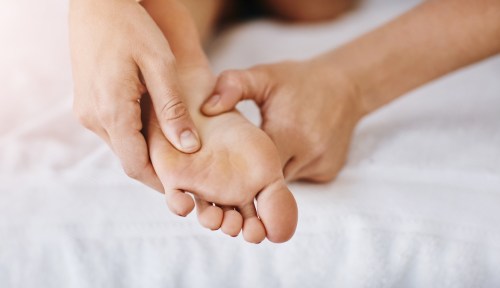Our editors independently select these products. Making a purchase through our links may earn Well+Good a commission
7 Foot Massagers That Will Make Your Tired, Sore Feet *So* Happy
If your feet are in need of some love, try one of these best foot massager options. Some are heated, some are cooling, all are relaxing.

Pre-COVID, the cause of most of the foot soreness I experienced came from wearing all kinds of hot-but-impractical shoes during nights out with friends, drinking cocktails in crowded bars and flirting with strangers. These days my footwear is predominantly fuzzy slippers and this particular pair of Havaianas flip-flops, and I spend most of my day on my couch staring at my computer or in bed staring at my phone. So basically, while my feet don’t get sore as frequently, clearly I could use some self-care. Regardless of the reason your feet are sore—or you’re tired, or sad about life—a foot massage can be game-changing—as I’ve recently discovered during my quest to find the best foot massager. Another thing I recently discovered? The amount of people who will post reviews, including pictures of their feet. At-home massagers are also wonderful if you’re weird about feet (like I am) and don’t want another human to touch them, or have been isolated inside your apartment lacking human touch for a year (also like I am).
Shop the best foot massagers that will make your feet happy (if you remember what happiness feels like):
1. HoMedics Elite Foot Massager with Heat, $70
One of my aspirations is to own a car that has seat warmers, because for some reason that signals “real adult” to my brain. Until that happens, this heated massager is a solid stand-in.
Shop now: HoMedics Elite Foot Massager with Heat, $70
2. TheraFlow Foot Massager, $17
This product has over 13k five-star reviews, and I would like everyone to appreciate the lengths I went to (five extra minutes) in order to find a photo that didn’t have real feet in it.
Shop now: TheraFlow Foot Massager, $17
3. Theragun Elite, $399
If you haven’t used a Theragun on your feet, you are missing out.
Shop now: Theragun Elite, $399
4. Dr. Scholl’s Massage Ball, $7
You can fill this massage ball with hot or cold water, depending on whether you want to reduce inflammation or soreness. It’s dishwasher safe, meaning it’s easy to clean after you’ve rubbed your feet all over it.
Shop now: Dr. Scholl’s Massage Ball, $7
5. Renpho Foot Massager, $140
My feet are always cold and I am always losing my socks, so this heated slipper-like massager that I can nestle my feet into is kind of ideal.
Shop now: Renpho Foot Massager, $140
6. Nekteck Foot Massager, $60
Another great heated option, this features six massage heads and 16 massage nodes for an extra relaxing experience.
Shop now: Nekteck Foot Massager, $60
7. Snailax 2-in-1 Shiatsu Foot and Back Massager with Heat, $50
Unfortunate brand name aside, this product is quite cozy and helps ease foot soreness. Plus, you can detach the top cover and use it is a back massager or period-cramp heating pad.
Shop now: Snailax 2-in-1 Shiatsu Foot and Back Massager with Heat, $50
Oh hi! You look like someone who loves free workouts, discounts for cult-fave wellness brands, and exclusive Well+Good content. Sign up for Well+, our online community of wellness insiders, and unlock your rewards instantly.
Sign Up for Our Daily Newsletter
Get all the latest in wellness, trends, food, fitness, beauty, and more delivered right to your inbox.
Got it, you've been added to our email list.










